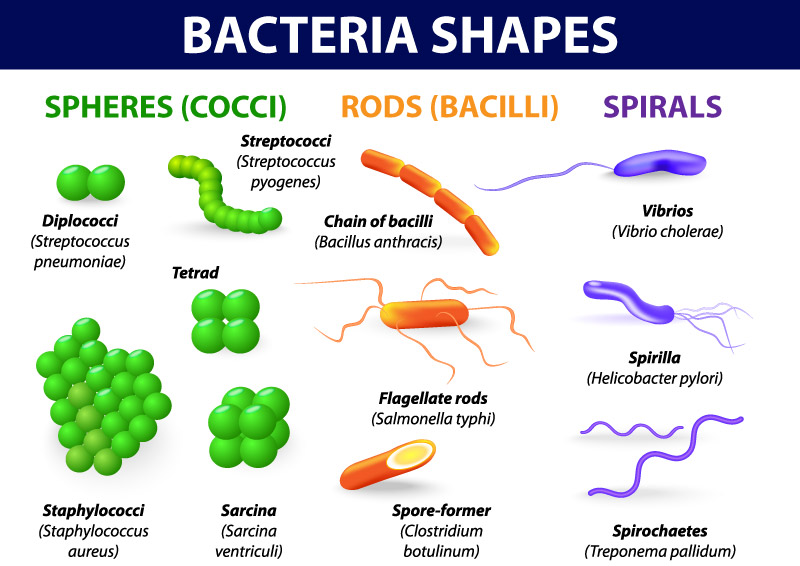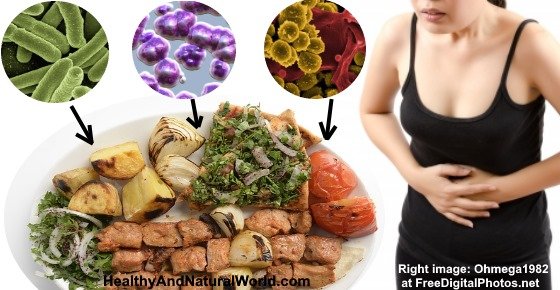MICROBES AND FOOD: PROSPECTS AND CHALLENGES......Episode 1.
Globally, we are becoming increasingly aware that microorganisms are the basis of the biosphere (i.e.the zone of living things/life on Earth). They are the ancestors of all living things and the support system for all other forms of life. However, certain microorganisms pose a threat to human health as well as to the health of plants and animals. Thus, microorganisms being the foundation of the biosphere and major determinants of human health, they therefore play primary and fundamental roles in life on Earth. Consequently, the study of microorganisms is critical to the study of all living things and Microbiology is essential for the study and understanding of all life on this planet.
Microbiology is often defined as the study of microscopic organisms and agents (e.g. viruses) too small to be seen by the naked eye. Microorganisms are living minute (ranging in size from 0.2 x 0.5μm to 0.3 x 2.0 μm) organisms which can only be seen with a microscope and they include bacteria, moulds, yeasts, protozoa, algae and viruses (classified as microorganism due to their small size and not viability).
However, bread molds and some algae are studied by microbiologists (due to some of their characteristics) yet, they are visible to the naked eye. Interestingly, two bacterial genera (Thiomargarita namibiensis) and Epulopiscium fishelsoni were discovered recently. Thiomargarita namibiensis was discovered in 1999 off the coast of Nambia. It is about 3 million times the volume of a normal bacterial cell with width ranging between 0.1mm and 0.3mm but a few are approximately 1.0 mm in length. In contrast, Epulopiscium fishelsoni was discovered in 1985 inside the intestines of a brown surgeonfish and it ranges from a length of about 30 micrometers (μm) to 600 micrometers (μm) and a volume of greater than 2,000 fold

Food spoilage is the alteration of the quality characteristics (such as appearance, taste, texture, odour) due to enzymatic and microbial attacks of food thereby making the food unacceptable.
Food has several definitions but that by the Joint FAO/WHO Codex Alimentarius Commission (CAC) of the United Nations is most comprehensive and it defines food as “any substance, whether processed,semi-processed or raw, which is intended for human consumption and includes drink, chewing gum and any substance which has been used in the manufacture, preparation, processing or treatment of food but does not include cosmetics or tobacco or substances used only as drugs” (CAC, 1980).
Food safety is a major focus in Food Microbiology and it describes handling, preparation/ processing and storage of food in ways that prevent food-borne illnesses and food poisoning. This involves safety measures that emphasize “tracking” between industry and the market and then between the market and the consumer (hence, there are cases of processed food recalls especially in developed countries).
In developed countries, there are intricate and well-articulated standards for monitoring food safety but in many less developed countries (including Nigeria), these measures are at the formative/review stages. Questions concerning the relevance of microbiological standards in the country had earlier been raised. However, it is gratifying to observe that a comprehensive review draft document on National Policy on Food Safety and its Implementation Strategy is now being considered under the leadership of the Federal Ministry of Health (FMOH) supported by some other Ministries, Parastatals and Agencies.
Globally, there is a growing concern that food often supports the survival and growth of pathogenic microorganisms thereby, exposing especially babies, children and the elderly to potential food hazards. Similarly, there are indications in the United Kingdom and elsewhere that the incidence of food poisoning is much higher than official statistics show due to under-reporting because it is common knowledge that many cases occur at home yet, are not reported since such victims do not necessarily consult their doctors when they suffer the symptoms of gastro-enteritis (inflammation of the gastrointestinal tract), abdominal pains, diarrhoea and vomiting. The situation is even worse in developing countries including ours where such statistics are virtually unavailable but food-borne illnesses of microbial origin are major causes of death in developing countries (WHO, 2002).
In addition, the lack of proper medical consultation in this country often leads to self-medication and abuse which ultimately results in high rates of incidence of antimicrobial resistance. It is noteworthy that toxins country (originating from bacteria or moulds (i.e. mycotoxins which are carcinogens) are not usually liable to heat conversion to non-toxic components because of their high temperature stability (usually above 150oC). Therefore, the practice of trimming moulded/fungal-infected agricultural produce for consumption with the hope that microbial hazards have been removed is very dangerous and consumers are therefore highly discouraged from such practices.
Shelf life is the length of time that a commodity may be stored without becoming unfit/ unwholesome for human use or consumption. It applies to foods/beverages, pharmaceutical products, chemicals and many other perishable items. The common labels on food with respect to shelf life are: best before or sell by/use by dates. However, shelf life is comparable with expiration date since both emphasise quality and safety. Therefore, food products should be removed from the shelf before the indicated dates.
Food Security- According to FAO/WHO (2014), it is defined as a condition where all people, at all times have physical and economic access to sufficient, safe and nutritious food to meet their dietary needs and food preferences for an active and healthy life. It is complex and is built on three pillars:
• Food availability: sufficient quantities of food available on a consistent basis.
• Food access: having sufficient resources to obtain appropriate foods for nutritious diets.
• Food use: appropriate use based on knowledge of basic nutrition and care as well as adequate water and sanitation.
Hazard Analysis and Critical Control Point (HACCP) is a systematic preventive approach (concept) to food safety from biological, chemical and physical hazards in food production processes to ensure the safety of food by reducing these hazards to acceptable safe level. Thus, this approach emphasises the prevention of hazards at all the food production stages of a food chain rather than the tradition of analyzing the finished food product (i.e. postmortem approach).
It therefore focuses on microbial/hazard control of foods from farm to table (a total quality management approach). HACCP was conceived in the 1960s when the US National Aeronautics and Space Administration (NASA) asked Pillsbury (a major food company in the US) to design and manufacture the first foods for space flights. Since then, HACCP has become adopted by the food industries and recognized internationally by government regulatory agencies and FAO/WHO.
Microbial food poisoning is a term that describes an illness caused by eating or drinking food contaminated with bacteria, viruses, parasites, toxins or chemicals. Two categories are known namely: food infection and food intoxication.
Food infection occurs where the microorganism itself grows inside the stomach (gastro-intestinal tract) of the victim to produce high microbial population to attain infective load/dose and is the source of the symptoms/illness including diarrhoea, stomach cramps, fever and chills. Due to this process of bacterial/viral multiplication/population increase, the symptoms take longer time (approximately hours to days) to appear. The most common microorganisms responsible for food infection include Salmonella spp., Campylobacter jejuni, Listeria monocytogenes, Shigella spp., Vibrio parahaemolyticus and Norwalk viruses. The main treatment for severe bacterial food infection is the use of antibiotics.
Unfortunately, the common practice here in Nigeria and many other countries is to prescribe multiple antibiotics or broadspectrum antibiotics in place of narrow-spectrum drugs without the actual identification of the specific causative pathogen(s). This is often due to lack of appropriate diagnostic facilities and sometimes the expertise.
Food intoxication results from the consumption of a chemical or natural toxin (often an exotoxin i.e toxin produced by the organism and released to the immediate environment) and is consumed along with the food thereby causing the symptoms/illness. The symptoms appear sooner (within few hours of consumption of the contaminated food) because the toxins are already produced (preformed) in the food prior to consumption. This explains the variations in symptom/illness manifestation among people who must have consumed the same contaminated food. For example, a few may experience mild symptoms while others suffer more severe symptoms/illness depending on the amount of the toxin consumed along with the food.

These are the Growth Factors Associated with Food Microorganisms
All microorganisms require moisture, a food source, enough time, and suitable temperatures to grow and multiply.
Other factors affecting growth:
- Varying requirements for Oxygen (aerobic vs. anaerobic bacteria, e.g.)
- pH - acidity or alkalinity (most microorganisms prefer a pH near neutral [pH = 7.0])
- Darkness vs. Light (Ultraviolet light is lethal to microorganisms)
The most common pathogens responsible for food intoxications include Staphylococcus aureus, Clostridium botulinum, Escherichia coli O157: H7 and Clostridium perfringens(USFDA, 2014). Both food infection and food intoxication produce similar food poisoning–related symptoms and are not always easy to diagnose based on symptoms alone hence the causative microorganism(s) should be identified as quickly as possible using rapid diagnostic methods for adequate treatment. Regretably, most of the necessary facilities are not available in most parts of the country.
Conclusively, the consumption of a chemical or natural toxin (often an exotoxin i.e toxin produced by the organism and released to the immediate environment) and is consumed along with the food thereby causing the symptoms/illness.
This is caused as a result of eating or drinking food contaminated with bacteria, viruses, parasites, toxins or chemicals, They are categorized into two as regards their mode of action that is food intoxication and food infection.
This post is just a begining and looking for the the subsequent post for contiunation of the topic.
thank you for reding.
Being A SteemStem Member
This is very good post, because microorganisms are the basic problem that led to the effect the food spoilage and consumption of the spoilt food led to food poison and food infection.